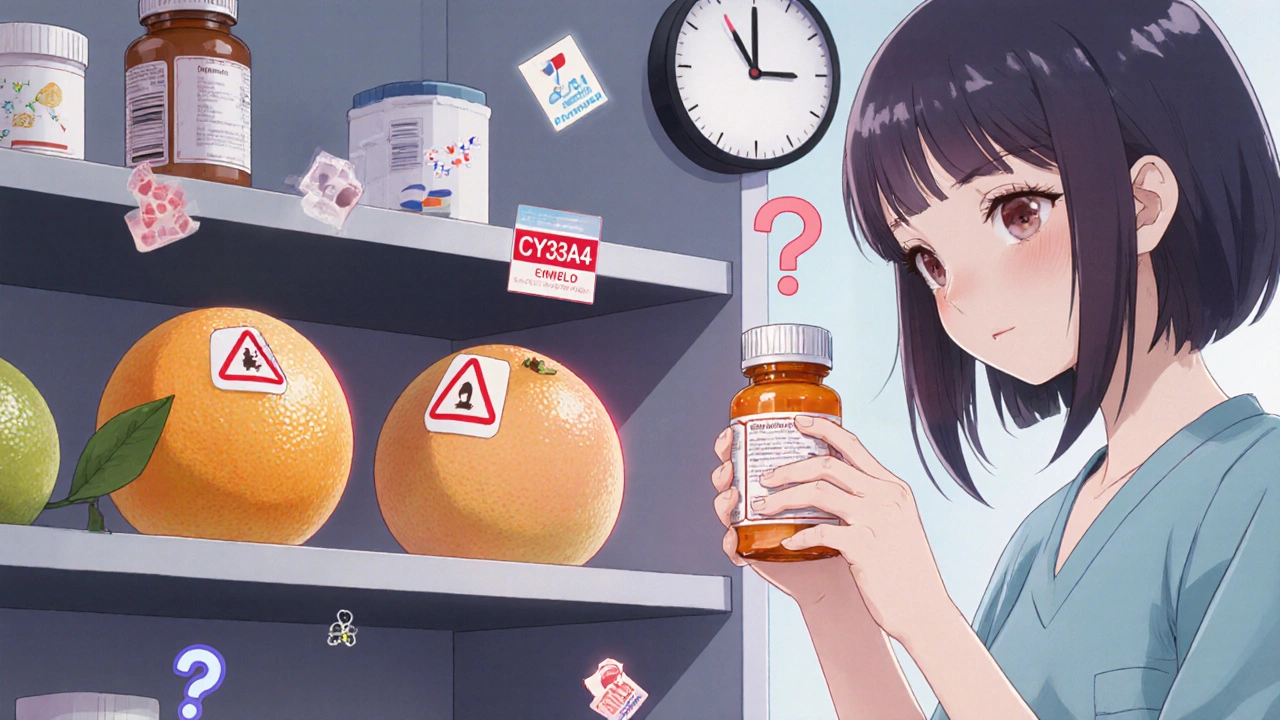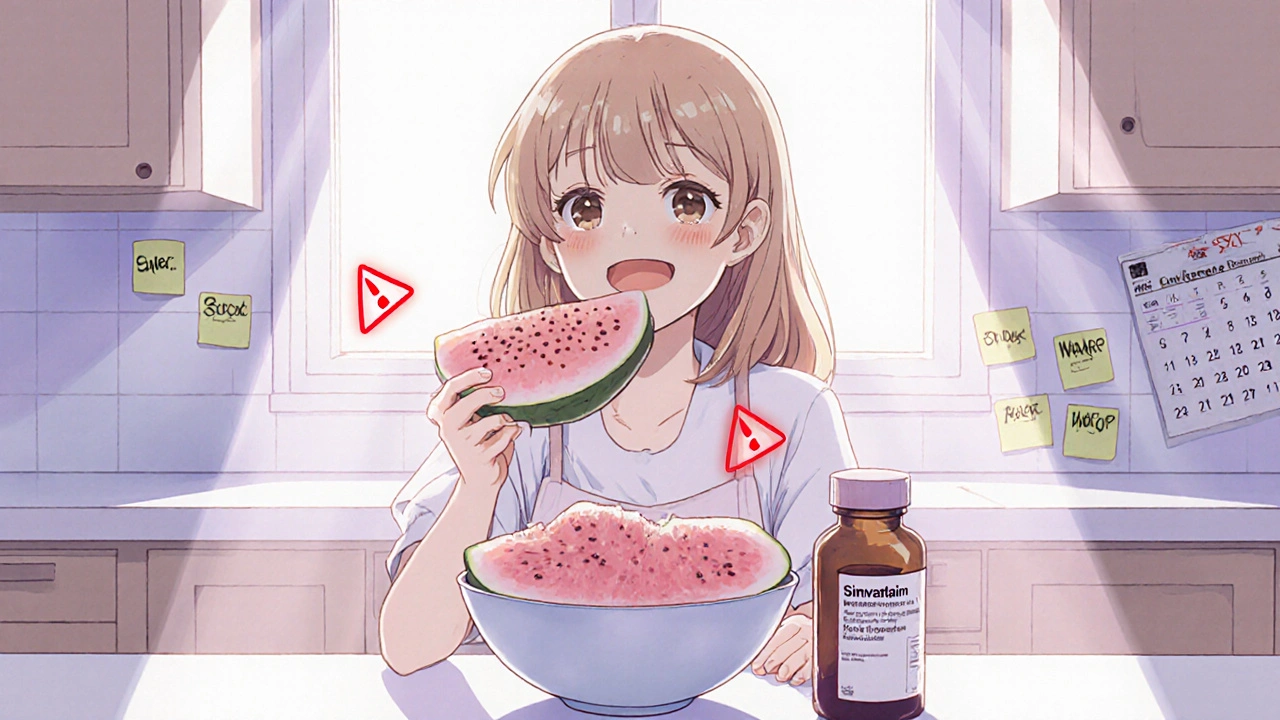Citrus Drug Interaction Checker
Safe Alternatives
Consider these citrus fruits that don't contain furanocoumarins:
- • Sweet oranges
- • Tangerines
- • Clementines
- • Lemons (in moderate amounts)
- • Limes (in moderate amounts)
Most people know grapefruit can mess with their meds. But if you’re eating pomelo or savoring Seville orange marmalade on your toast, you might be at risk too-and no one told you. These fruits aren’t just exotic snacks. They’re powerful enough to spike drug levels in your blood, sometimes to dangerous levels. And unlike grapefruit, they rarely come with warning labels.
Why These Fruits Are More Dangerous Than You Think
Pomelo and Seville orange aren’t just cousins of grapefruit-they’re its louder, stronger siblings. Both contain high levels of furanocoumarins, especially bergamottin and 6’,7’-dihydroxybergamottin. These compounds shut down an enzyme in your gut called CYP3A4, which normally breaks down medications before they enter your bloodstream. When it’s blocked, your body absorbs way more of the drug than it should.
Studies show pomelo has higher concentrations of these compounds than grapefruit. One 2014 study in the Journal of Agricultural and Food Chemistry found pomelo juice contained 1.5-2.5 μM of bergamottin, while grapefruit had 1.0-2.0 μM. Seville orange? Even worse. Some varieties hit 3.0-4.0 μM. That’s up to 30% more than grapefruit. And it doesn’t take much: just 200 mL-about a cup-of juice can trigger an interaction.
The effect isn’t temporary. These compounds bind to the enzyme permanently. Your body has to make new enzymes to replace them, which takes 24 to 72 hours. So even if you eat pomelo at breakfast, your meds taken at night could still be affected. That’s why doctors say you need to avoid these fruits for at least three days before and during treatment with certain drugs.
Which Medications Are at Risk?
Not all drugs are affected. The real danger lies with medications that rely heavily on CYP3A4 for breakdown. Here are the big ones:
- Statins like simvastatin and atorvastatin: Eating pomelo can spike simvastatin levels by up to 350%. That raises the risk of rhabdomyolysis-a rare but life-threatening muscle breakdown. One patient on Reddit reported muscle pain and kidney failure after eating pomelo daily for two weeks.
- Calcium channel blockers like amlodipine and felodipine: These are used for high blood pressure. When inhibited, they can cause dangerously low blood pressure, dizziness, or even heart rhythm problems.
- Immunosuppressants like tacrolimus and cyclosporine: Transplant patients are especially vulnerable. A 2011 case report showed Seville orange marmalade caused tacrolimus levels to jump 400%, leading to kidney toxicity and hospitalization.
- Benzodiazepines like midazolam and triazolam: These sedatives can become too strong, causing excessive drowsiness or breathing issues.
- Some antidepressants and antipsychotics: Including sertraline and quetiapine, which can accumulate and cause serotonin syndrome or irregular heartbeats.
Drugs metabolized by other enzymes-like CYP2D6 (used by many SSRIs)-aren’t affected. So if you’re on fluoxetine or sertraline, sweet oranges and tangerines are fine. But if you’re on simvastatin or tacrolimus? Even a small bite of pomelo could be risky.
Pomelo vs. Seville Orange: What’s the Difference?
They’re not the same fruit, but they’re equally dangerous.
Pomelo is huge-sometimes as big as a basketball. It’s sweet, mild, and often sold in Asian markets labeled as “Chinese grapefruit.” People assume it’s safe because it’s not bitter. But that’s a trap. Its flesh and juice contain the same furanocoumarins as grapefruit, sometimes more. A 2018 study in the British Journal of Clinical Pharmacology found pomelo increased simvastatin exposure more than grapefruit did.
Seville orange is sour, bitter, and rarely eaten raw. You’ll mostly find it in marmalade, especially in the UK and Europe. The peel and pulp are packed with furanocoumarins. One 2017 study in Food Chemistry found Seville orange peel had up to 50% more bergamottin than grapefruit peel. So even a tablespoon of marmalade can be enough to cause a problem.
And here’s the kicker: most people don’t realize marmalade is made from Seville oranges. If your jar just says “bitter orange marmalade,” you’re probably eating a drug interaction waiting to happen.
Why Nobody Warns You
Here’s the scary part: only 37% of pomelo and Seville orange products carry any warning about drug interactions. Compare that to 78% of grapefruit products. Why? Because grapefruit has been the focus for decades. Pomelo and Seville orange are less common in the U.S. and Canada, so regulators and retailers haven’t caught up.
A 2022 FDA compliance review found that most grocery stores don’t label these fruits at all. Pharmacies? Even worse. Only 29% of major pharmacy chains include pomelo or Seville orange in their electronic drug interaction alerts. A 2023 survey by the American Pharmacists Association showed only 42% of community pharmacists routinely ask patients about them.
Patients aren’t to blame. A 2023 Drugs.com review of 243 patients found 68% said they were never warned by their doctor or pharmacist about these fruits. One transplant patient on PatientsLikeMe wrote: “I ate marmalade every morning for years. No one ever said it could kill me.”
What You Should Do
If you’re on any of the medications listed above, here’s what to do:
- Check your meds. Look up your prescription on the University of Florida Center for Pharmacogenomics list. They track 107 drugs with known interactions.
- Ask your pharmacist. Don’t assume they know. Say: “Does my medication interact with pomelo or Seville orange?”
- Read labels. If you see “bitter orange,” “Citrus aurantium,” or “Seville orange” on marmalade, avoid it. If you’re unsure, call the manufacturer.
- Switch your citrus. Sweet oranges, tangerines, and clementines are safe. They don’t contain furanocoumarins. A 2022 Mayo Clinic survey found 82% of patients who switched to these fruits had no issues.
- Wait three days. If you accidentally eat one of these fruits, avoid your meds for at least 72 hours. Talk to your doctor before restarting.

What’s Changing? What’s Next?
The tide is turning. In 2023, the FDA proposed expanding warning labels to include all furanocoumarin-containing citrus fruits. The rule is expected to go into effect by mid-2025. The European Union already requires warnings on pomelo and Seville orange products in 17 countries.
Research is catching up too. The NIH just funded a $2.1 million study at the University of Washington to better understand how pomelo affects drug metabolism. And the American Society for Clinical Pharmacology and Therapeutics predicts provider awareness will rise 65% by 2027 thanks to better EHR alerts.
But until then, you’re on your own. Climate change is also making things unpredictable. A 2022 study in Nature Food found furanocoumarin levels in citrus can vary by up to 25% depending on growing conditions. A pomelo from Thailand might be safer than one from Florida. You can’t know without testing.
The Bottom Line
Don’t assume grapefruit is the only citrus fruit that can mess with your meds. Pomelo and Seville orange are just as dangerous-and far less understood. If you’re taking statins, blood pressure meds, or immunosuppressants, treat these fruits like you would grapefruit: avoid them entirely. Talk to your doctor. Read labels. Ask questions. Your life might depend on it.
Can I eat regular oranges if I’m on medication?
Yes. Sweet oranges, tangerines, and clementines are safe. They don’t contain furanocoumarins, the compounds that cause drug interactions. Only bitter citrus fruits like grapefruit, pomelo, and Seville orange are risky.
Is Seville orange marmalade really dangerous?
Yes. Seville orange peel and pulp contain high levels of furanocoumarins-even higher than grapefruit. A single tablespoon of marmalade can trigger a dangerous interaction with drugs like tacrolimus or simvastatin. Many people don’t realize marmalade is made from this bitter orange, so they eat it daily without knowing the risk.
How long do the effects last after eating pomelo?
Up to 72 hours. Furanocoumarins permanently disable the CYP3A4 enzyme in your gut. Your body needs to make new enzymes, which takes 1 to 3 days. That’s why you must avoid these fruits for at least three days before and during treatment with sensitive medications.
Do all citrus fruits cause drug interactions?
No. Only citrus fruits with high levels of furanocoumarins-grapefruit, pomelo, and Seville orange. Sweet oranges, lemons, limes, and mandarins are safe. Limes and lemons have very low levels and aren’t considered risky in normal amounts.
Why don’t drug labels warn about pomelo and Seville orange?
Because grapefruit has been the focus since the 1980s. Pomelo and Seville orange are less common in North America and Europe, so regulatory agencies and manufacturers haven’t prioritized warnings. But that’s changing. The FDA plans to expand labeling requirements by mid-2025.

peter richardson
October 29, 2025 AT 14:34So I’ve been eating Seville orange marmalade every morning for five years with my statin and never had a problem. Maybe I’m just lucky. Or maybe the studies are overblown. Either way, I’m not giving up my toast.
Uttam Patel
October 30, 2025 AT 03:39lol so the FDA is finally gonna label citrus like it’s a drug? next they’ll ban coffee because of caffeine interactions. chill out.
Nolan Kiser
October 31, 2025 AT 13:25Actually, this is critical info. I’m a clinical pharmacist and I’ve seen three patients hospitalized from pomelo juice + tacrolimus. One guy thought it was just "healthy fruit." No one warned him. The science is solid. CYP3A4 inhibition isn’t a myth-it’s a silent killer. If you’re on any of these meds, avoid pomelo and bitter orange like it’s poison. Because it is.
Prema Amrita
October 31, 2025 AT 23:00Just checked my meds. I’m on simvastatin. I had pomelo last week. Now I’m scared. Thanks for the warning. I’m switching to sweet oranges today. No more risks.
Vasudha Menia
November 2, 2025 AT 12:28Thank you so much for sharing this 💔 I’m a transplant patient and my marmalade was from Seville oranges. I had no idea. I’m calling my doctor right now. You saved me from a nightmare. ❤️
Cosmas Opurum
November 4, 2025 AT 04:55This is all part of the Big Pharma agenda. They want you scared of natural foods so you’ll keep buying their overpriced pills. Grapefruit? Sure. But pomelo? That’s just a fruit. They’re pushing fear to sell more lab-made drugs. Wake up. Eat your fruit. Trust nature, not the FDA.
Kirk Elifson
November 5, 2025 AT 05:51People are dying because they don’t know this? And we still let supermarkets sell these fruits without warning labels? This is criminal. Who’s responsible? The farmers? The grocers? The FDA? Someone needs to go to jail.
Robert Burruss
November 7, 2025 AT 01:23It’s fascinating how something so natural-fruit, something we’ve eaten for millennia-can have such profound biochemical consequences. We’ve built a medical system that treats biology like a machine, but we forget that biology is messy, contextual, and deeply personal. A cup of juice doesn’t just interact with a drug-it interacts with your body’s history, your metabolism, your genetics. Maybe the real issue isn’t the fruit… it’s our assumption that medicine can be standardized. Maybe we need to stop treating patients like data points and start treating them like people.
Alex Rose
November 8, 2025 AT 03:20Per CYP3A4-mediated first-pass metabolism inhibition via furanocoumarin-induced irreversible enzyme inactivation-yes, this is well-documented. But the clinical significance varies by pharmacokinetic profile. For drugs with narrow therapeutic indices like tacrolimus, yes, avoid. For others? Risk is dose-dependent and individual. Not all statins are equal. Simvastatin? High risk. Rosuvastatin? Minimal. Stop fearmongering. Educate, don’t alarm.